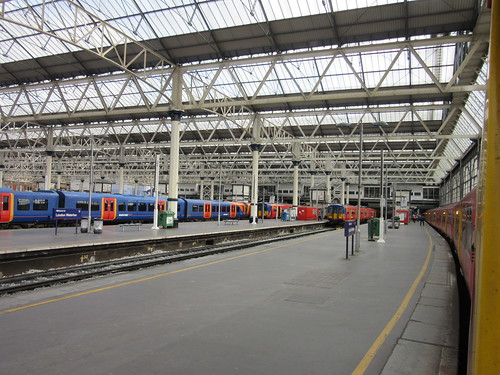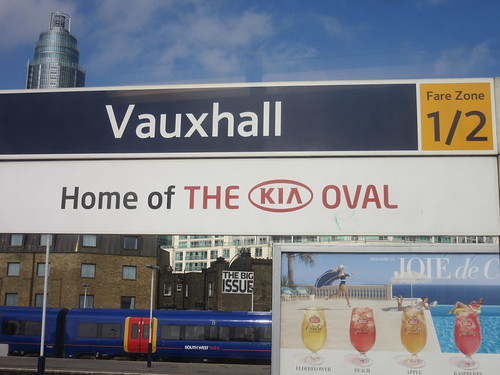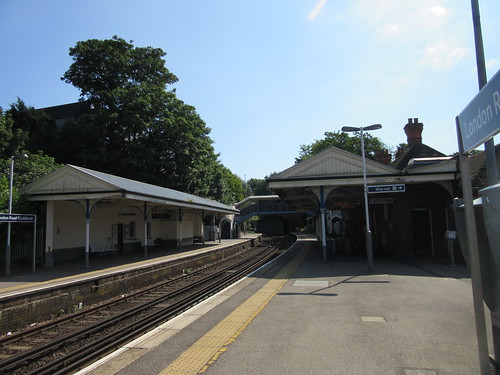The usual irritation of negotiating Euston's concourse to reach the Underground entrance followed. The area was packed with people and their luggage standing and studying the departure display, making it difficult to find a way through, particularly since other people were also attempting to criss-cross the concourse in different directions, often oblivious of the effect of their own wheeled luggage in the confined area. I caught a Northern Line train to Waterloo - crowded but tolerable.
The concourse at Waterloo was thronged but not as packed as Euston. Waterloo was the London terminus of the London and South Western Railway (L&SWR) and there's a little about this famous station here. South West Trains provide fast, frequent third-rail electric trains which stop at Guildford but I chose instead a South West Trains stopping train from Platform 1. South West Trains are part of the 'Stagecoach' group which operates a number of rail franchises ("let's have rail competition, but not too much").
 View across Waterloo station from platform 1.
View across Waterloo station from platform 1.
We left on time, and soon made a brief stop at Vauxhall, the nearest station to the Oval. In 2013, I rather grumpily wrote "The Oval (which we are now supposed to call 'The Brit Insurance Oval')". No longer - new nameboards at the station proclaim that Vauxhall is now "The home of the KIA Oval". At least, I think that's what is says. With the modern obsession with 'branding' the car company's logo replaces the letter 'A' with an inverted 'V'. I weep for the English language.

We ran fast through Queenstown Road and paused at Clapham Junction. There's a post about Clapham Junction (also touching on Vauxhall and Queenstown Road) here.
We continued to Raynes Park where we diverged from the main line to Woking and continued (stopping at all stations) to Epsom. Here, a branch trailed in on our left, originally built by the London, Brighton & South Coast Railway bringing trains from Mitcham and West Croydon directions. Epsom still has two island platforms providing four platform faces.
We continued through Ashtead to Leatherhead. After Leatherhead there's a junction where the straight-on route leads to Dorking and Horsham. This line was also built by the London, Brighton & South Coast Railway and the the 'Pre-Grouping Railway Junction Diagrams 1914' (see Maps below) show the line from Epsom to Leatherhead as 'L&SWR/LB&SCR Joint. Even today, it's a separate Train Operating Company which works the route through Epsom to Horsham - Southern.
At the junction, my train took the sharply-curved right-hand route leading to Effingham Junction where the L&SWR branch from Surbiton trailed in from the right (having passed through the rather exotically-named station of Cobham and Stoke D'Abernon). At Effingham Junction, there's a storage and maintenance depot for Multi Purpose Vehicles. Railway Multi Purpose Vehicles are used variously for rail head treatment, weed spraying and conductor rail de-icing but no 'hardware' was on show.
 Effingham Junction, showing the MPV Maintenance Depot.
Effingham Junction, showing the MPV Maintenance Depot.
We soon reached the penultimate stop for the service at 'London Road (Guildford)', where I alighted. This is a very rural station in contrast with the final stop for my train at Guildford itself. The London Road station which I was brought up with was located in Manchester, now renamed 'Piccadilly' but I discovered that there are two 'London Road' stations south of London - one at Guildford and one at Brighton.
 London Road (Guildford).
London Road (Guildford).
A brisk walk along London Road led me to 'Lionsmeet' and, after an enjoyable day at Guildford Model Engineering Society (described here), I retraced my steps to 'London Road (Guildford)' station. For variety, I decided to travel to Guildford Station and return towards London on a fast service.
 View of Guildford Station from the covered footbridge, looking towards London. The train I'd arrived on is on the right in Platform 1, the 'Cobham Bay'.
View of Guildford Station from the covered footbridge, looking towards London. The train I'd arrived on is on the right in Platform 1, the 'Cobham Bay'.
 View of Guildford Station from the covered footbridge, looking away from London.
View of Guildford Station from the covered footbridge, looking away from London.
Within a few minutes, I was on an 'Up' train which stopped at Worplesdon, Woking (where we joined the line from Basingstoke and the West) and then was 'Fast' to Clapham Junction. I left the service here and crossed to the former LB&SCR platforms to catch a 'Down' train to East Croydon, since I wanted to visit my friend Rita.
Maps
[1] 'Pre-Grouping Railway Junction Diagrams 1914', published by Ian Allen (ISBN 0 7110 1256 3).
[2] Details of the modern railways south of London are shown in one of the 'Quail Track Diagrams' books:- 'Railway Track Diagrams Book 5: Southern and TfL' Third Edition, published by TRACKmaps (ISBN 978-0-9549866-4-3).
Related information on other websites
Historic:
London and South Western Railway (Wikipedia).
London, Brighton and South Coast Railway (Wikipedia).
Modern:
South West Trains.
South West Trains Network Map.
Southern.
Southern Network Map.
Related posts on this website
Waterloo Station, London.
Clapham Junction Station, London
My pictures
London: former 'Southern' lines.
